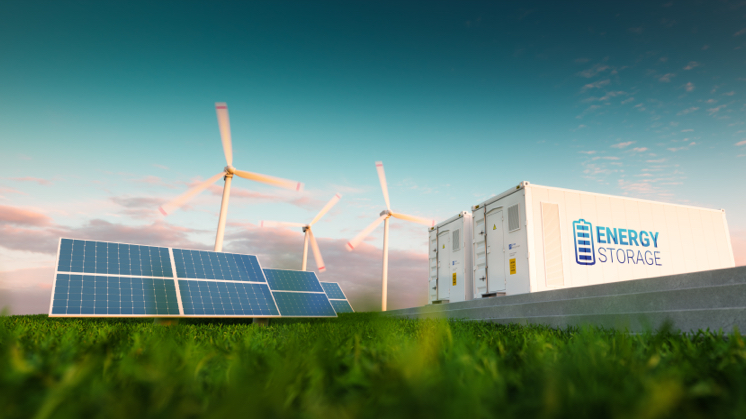
Apr . 18, 2024 12:09 Kembali ke daftar
Energy storage: the key to a decarbonised future
Efficient penyimpanan energi is a fundamental pillar of the energy transition: allowing flexible renewable energy production and guaranteeing its integration into the grid. Find out which storage systems are the most efficient and which ones promise to drive the much-needed transition towards a decarbonised electricity system.
Energy storage, in addition to integrating renewables, brings efficiency savings to the electrical grid.
Electricity can be easily generated, transported and transformed. However, up until now it has not been possible to store it in a practical, easy and cost-effective way. This means that electricity needs to be generated continuously according to demand and, consequently, renewable energies require supporting storage systems for their integration, to avoid drops in clean energy during supply troughs and to provide greater efficiency and security to the electrical grid.
In a world that is in the midst of a transition from fossil fuels to renewable sources, such as wind and solar energy, improved electrical energy storage is vital to support these technologies, ensuring that electrical grids can be balanced and can contribute to the maximisation of every green megawatt generated.
Main energy storage systems
Electricity cannot be stored as such and therefore it needs to be transformed into other types of energy, such as mechanical or chemical. Storage systems can add value at every stage of the supply chain. Depending on their capacity, penyimpanan energi systems are divided into: large-scale storage, which is used in places where GW scale is required; storage in the grid and in power generation assets, where the MW scale is used and, finally, storage at the end-user level, which applies to the residential level and works with kW.
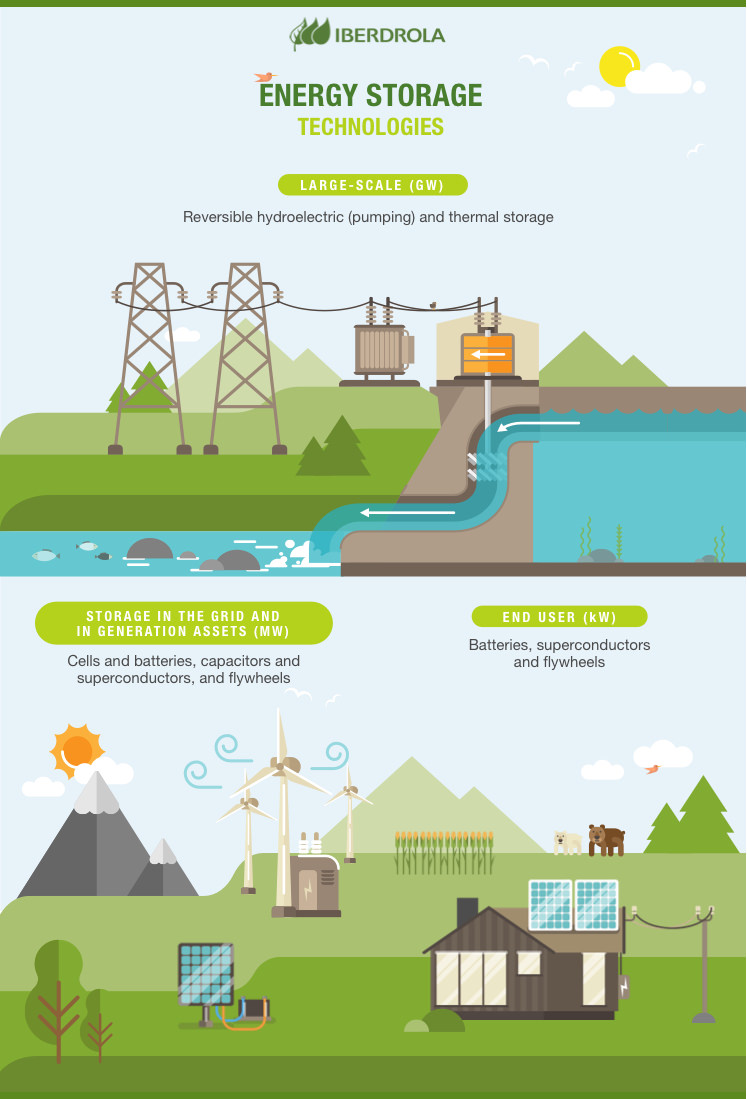
![]() SEE INFOGRAPHIC: Energy storage technologies [PDF]
SEE INFOGRAPHIC: Energy storage technologies [PDF]
Currently, the following list shows the ways to accumulate energy and the main technologies that allow efficient energy transformation and storage:
 Hydroelectric pumping
Hydroelectric pumping
The most efficient large-scale storage system in operation. This is a cost-effective and proven technology that provides stability to the electrical system and can generate significant levels of clean energy with rapid response times.
 Compressed air
Compressed air
These facilities have a reversible motor that, during periods of excess energy, ambient air is stored at high pressures in underground cubicles. It is a mechanical storage system comparable in capacity to hydroelectric pumping.
 Thermal storage
Thermal storage
It consists in accumulating energy in materials that allow it to be retained and released in a controlled manner, through methods ranging from cooling through ice accumulation to exposure to extremely high temperatures.
 Supercapacitor
Supercapacitor
This is a device capable of storing large amounts of electrical energy in the form of electrostatic charges, meaning there are no chemical reactions. Supercapacitors can be charged or discharged in a matter of seconds, thus being ideal for responding to energy peaks or brief supply interruptions.
 Flywheels
Flywheels
This is a mechanical storage system consisting of a metal disc that starts to spin when a torque is applied to it, then, with the action of braking the wheel applying a firm braking torque, electrical energy is conserved in kinetic form.
 Batteries
Batteries
This is a device that stores energy in chemical compounds capable of generating electrical charge. There are many types, such as lead-acid batteries, lithium ion or nickel cadmium batteries. The main advantages of batteries are their rapid response (milliseconds), their ease of installation and scalability and, finally, the multiple benefits they can bring to renewable assets to which they connect.
 Hydrogen fuel cells
Hydrogen fuel cells
This is a type of continuous chemical storage. It differs from batteries in that it is supplied continuously with hydrogen from the outside allowing its constant use. There are other types of fuel cells, but hydrogen is the most commonly-used fuel.
Lithium batteries: the future of storage
In recent years, the renewable energy sector has seen in lithium-ion batteries the solution to its main problem: the storage of generated energy. Being one of the smallest elements in the periodic table, lithium has a high electrochemical potential and can accumulate large amounts of energy. With the desirable low weight and high efficiency, only one obstacle has so far prevented lithium batteries from becoming the standard storage technology for renewable energy: their high cost.
This situation, however, seems to be changing. According to a recent study by Bloomberg NEF (BNEF), the cost of lithium-ion batteries will be significantly reduced in the coming years — beyond even the 85% reduction that occurred from 2010 to 2018. Specifically, BNEF predicts a 50% reduction in the costs of lithium-ion batteries per kW/h by 2030, as demand takes off in two different markets: stationary storage and electric vehicles.
This will lead to worldwide energy storage facilities multiplying exponentially, from modest 9GW/17GWh implemented from 2018 to 1,095 GW/2,850 GWh by 2040. This dramatic increase will require an estimated investment of US$662 billion.
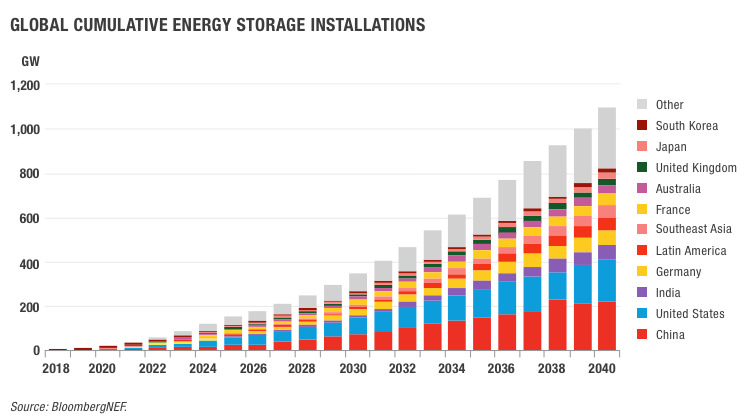
According to BNEF forecasts, the total demand for batteries in the sectors of stationary storage and electric vehicles will be 4,584 GWh by 2040, which, in addition to supporting the energy transition, will be a great opportunity for battery manufacturers and extraction companies of the components required, such as lithium, cobalt and nickel.
-
Wireless DC Charging: The Next Frontier in Contactless EV Power Delivery
BeritaAug.04,2025
-
Hybrid BMS Energy Controls: Integrating Renewable Energy Sources
BeritaAug.04,2025
-
Blockchain for Secure and Decentralized EMS Power Systems
BeritaAug.04,2025
-
AI-Driven for Smart Grids: Energy Management System (EMS)
BeritaAug.04,2025
-
Advanced Distribution Management System (ADMS) Energy
BeritaAug.04,2025
-
5G-Enhanced BMS Energy Savings: Ultra-Low Latency Control
BeritaAug.04,2025

Mar . 02, 2024 10:45 Kembali ke daftar
Energy storage: the key to a decarbonised future
Energy storage plays a crucial role in the transition towards a decarbonised future. It is a key element that enables flexible renewable energy production and ensures its seamless integration into the grid. As the world shifts away from fossil fuels towards renewable sources like wind and solar energy, improved electrical energy storage becomes essential. This ensures that electrical grids can be balanced effectively, maximizing the utilization of every green megawatt generated. With the growing focus on sustainability and reducing carbon emissions, identifying and implementing efficient energy storage systems is paramount for a sustainable energy future.
Various energy storage systems play a significant role in facilitating efficient energy transformation and storage. These systems are essential for ensuring the stability of the electrical grid and maximizing clean energy generation. Some of the main energy storage systems currently in operation include hydroelectric pumping, compressed air, thermal storage, supercapacitors, flywheels, batteries, and hydrogen fuel cells. Each of these systems has unique characteristics and advantages, catering to different storage needs and capacities. From large-scale storage systems like hydroelectric pumping to smaller-scale options like batteries for residential use, these technologies contribute to a diversified and resilient energy storage infrastructure.
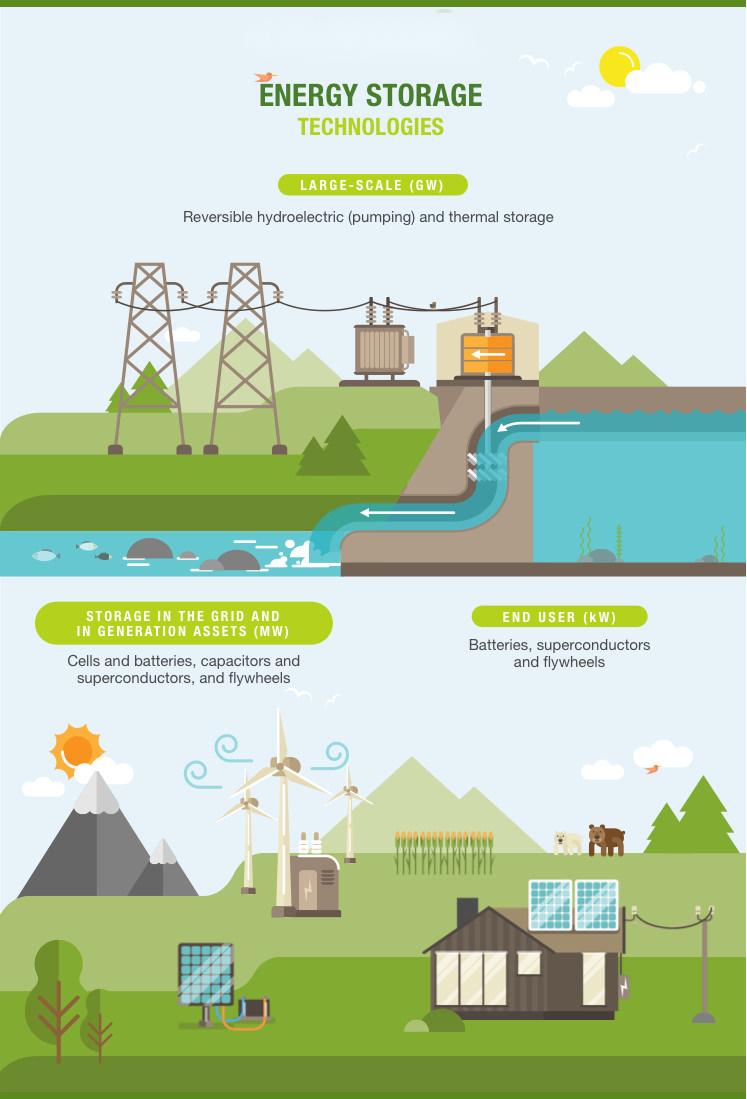
Hydroelectric pumping stands out as one of the most efficient large-scale storage systems in operation. This cost-effective and proven technology provides stability to the electrical system and enables the generation of significant levels of clean energy with rapid response times. Compressed air storage facilities utilize reversible motors to store ambient air at high pressures during periods of excess energy. This mechanical storage system, comparable in capacity to hydroelectric pumping, offers a reliable means of energy storage. Thermal storage involves accumulating energy in materials that can be retained and released in a controlled manner, offering flexibility in managing energy demands.
Supercapacitors are devices designed to store large amounts of electrical energy in the form of electrostatic charges, with no chemical reactions involved. These devices are characterized by their ability to be charged or discharged within seconds, making them ideal for responding to energy peaks and interruptions. Flywheels represent a mechanical storage system that conserves electrical energy in kinetic form by spinning a metal disc with the application of torque. Batteries, including various types like lead-acid, lithium-ion, and nickel-cadmium batteries, store energy in chemical compounds and provide rapid response times, ease of installation, and scalability, making them valuable assets for renewable energy integration.
Lithium-ion batteries have emerged as a promising solution for energy storage in the renewable energy sector. With their high electrochemical potential and energy storage capacity, lithium-ion batteries offer an efficient and lightweight option for storing generated energy. Despite their initial high cost, recent projections suggest a significant reduction in the cost of lithium-ion batteries in the coming years. Studies by Bloomberg NEF indicate a potential 50% reduction in the costs of lithium-ion batteries per kW/h by 2030, driven by increasing demand in stationary storage and electric vehicles markets. This reduction in costs is expected to accelerate the adoption of lithium-ion batteries as a standard storage technology for renewable energy systems.
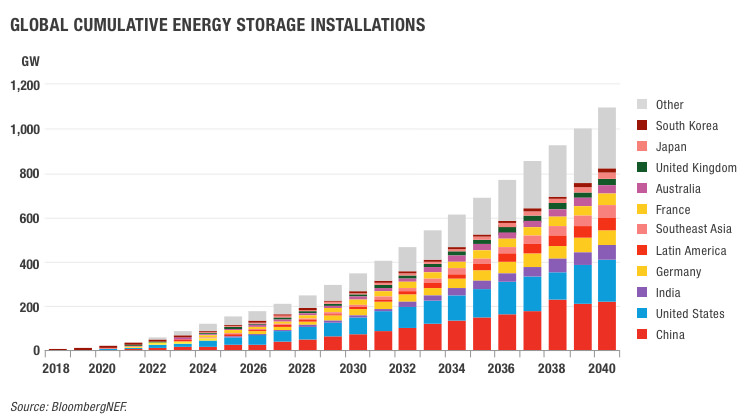
The forecasted growth of energy storage facilities worldwide is staggering, with an estimated increase from 9GW/17GWh in 2018 to 1,095 GW/2,850 GWh by 2040. This exponential growth will require a substantial investment of approximately US$662 billion. The demand for batteries in the sectors of stationary storage and electric vehicles is projected to reach 4,584 GWh by 2040. This surge in demand not only supports the energy transition towards decarbonisation but also presents a significant opportunity for battery manufacturers and extraction companies of components like lithium, cobalt, and nickel. The rising demand for energy storage solutions underscores the critical role these technologies will play in shaping a sustainable and decarbonised future.
In conclusion, energy storage technologies are essential for enabling a transition towards a decarbonised electricity system. From large-scale systems like hydroelectric pumping to advanced solutions like lithium-ion batteries, a diverse range of energy storage options are available to support renewable energy integration and grid stability. The rapid advancements in energy storage technologies, coupled with decreasing costs and increasing demand, pave the way for a sustainable energy future. By harnessing the potential of efficient energy storage systems, countries can accelerate their transition towards cleaner, more sustainable energy sources, reducing carbon emissions and mitigating the impacts of climate change.
-
Wireless DC Charging: The Next Frontier in Contactless EV Power Delivery
BeritaAug.04,2025
-
Hybrid BMS Energy Controls: Integrating Renewable Energy Sources
BeritaAug.04,2025
-
Blockchain for Secure and Decentralized EMS Power Systems
BeritaAug.04,2025
-
AI-Driven for Smart Grids: Energy Management System (EMS)
BeritaAug.04,2025
-
Advanced Distribution Management System (ADMS) Energy
BeritaAug.04,2025
-
5G-Enhanced BMS Energy Savings: Ultra-Low Latency Control
BeritaAug.04,2025
























